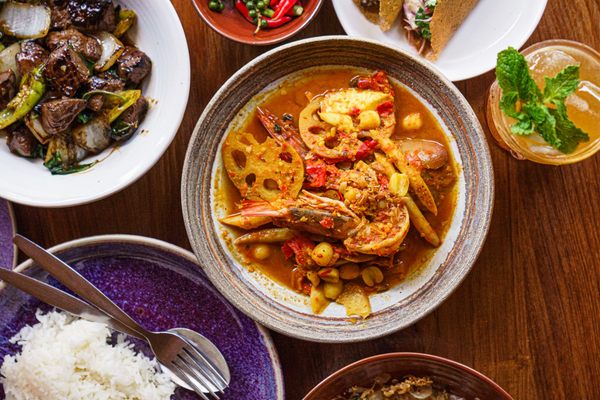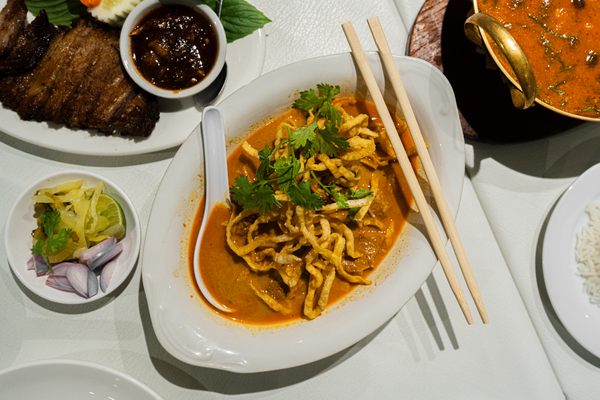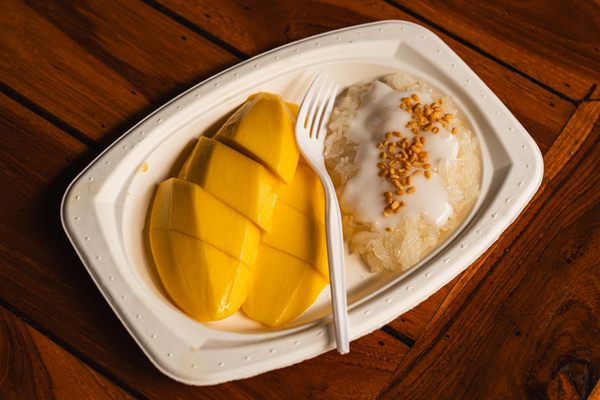Medieval Chefs Would Have Liked Dessert Hummus
Recipes in Arabic cookbooks included everything from rose hips to cinnamon.
Last summer, Sabra, one of America’s leading producers of hummus, announced three new flavors: Barbecue, Buffalo (as in wings), and Southwest. Not to be outdone, Fresh Cravings, a contender for dominance in the retail hummus market, debuted two new flavors of its own later that year: Tajín Chili Lime and Dill Pickle. These new additions, Fresh Cravings president Nicole Parker said in a statement, represented her company’s “commitment to pushing the boundaries of hummus flavor innovation.”
Yet some say those boundaries have been pushed a bit too far. Phony “imposters,” was renowned Israeli-born British chef Yotam Ottolenghi’s summary judgment of flavors like beetroot or avocado hummus back in 2018, when such trendy concoctions were beginning to gain ground. Even the otherwise family-friendly Bon Appetit magazine published an article called “WTF Does Dessert Hummus Taste Like?” when Brownie Batter and Snickerdoodle hummus first hit the market.
But while today’s hummus manufacturers have been tripping over each other to add ingredients to the standard Middle Eastern dip of mashed chickpeas, tahini, lemon juice, and garlic, sophisticated cooks in medieval kitchens across the Arab world had been adding fanciful ingredients to their hummus for centuries.

In the 14th century, the anonymous author of Kanz al-fawā’id fi tanwī’ al-mawā’id, or The Treasure of Useful Advice for the Composition of a Varied Table, instructed readers to “take boiled chickpeas, press them [through a sieve] to mash them. Put the mash in a porcelain bowl, sprinkle on it crushed salt, cumin, cassia, and anise seeds, all crushed. Also add olive oil and murri [a fermented condiment, similar to soy sauce or Asian fish sauce], and serve.” In a coda, the author advised that the dish “is even more delicious if you add to it [leeks], mint, and salt-preserved lemon.”
The 14th-century Kitab Wasf al-At’ima al-Mu’tada (The Book of Familiar Foods), based on an earlier, 13th century Baghdadi cookbook suggests adding tahini, oil, and vinegar to a base of boiled and mashed chickpeas. It also calls for over a dozen spices, including mace, green cardamom, nutmeg, Ceylon cinnamon, and toasted caraway, in addition to fresh mint and parsley, a variety of nuts (walnuts, hazelnuts, almonds, pistachios), preserved lemons, and olives. The recipe recommends smearing the dense, richly-spiced mixture on a plate and letting it sit overnight.
The results, the recipe’s anonymous author concludes, are well worth the wait: “Eaten, it comes out excellently, God the Most High willing,” a devotional phrase common throughout medieval Arabic cookbooks.

The sheer amount and variety of costly, exotic spices available, and the fact that these recipes appear in cookbooks at all, are a good indication of what sort of diners were dipping into these elaborate versions of hummus kassa (mashed chickpeas), the generic name for medieval hummus. “Cookbooks were not written for the working classes. They were an expensive luxury for well-to-do households with many servants and staff,” says independent scholar and medieval Arabic cookbook authority Nawal Nasrallah, who in 2017 published an English translation of the Kanz, under the title Treasure Trove of Benefits and Variety at the Table.
The complexity of the nearly dozen recipes for hummus in the Kanz, plus similarly elaborate versions in other Arabic cookbooks of the time, reflect the lavish, courtly cuisine of Islam’s great medieval empires. Culinary historian Charles Perry has noted that, in this era, there were more cookbooks written in Arabic than in the rest of the world’s languages combined.
This was the fabled age that produced the Arabian Nights, when Baghdad and the Abbasid caliphate (750-1258) set the standard for sophistication and elegance at the dinner table. Accolades for the culinary arts poured from the pens of doctors, philosophers, princes, and poets alike.
Baghdad’s busy marketplace was “where all the world’s wealth was gathered and all the blessings of the universe existed” as one 9th-century Arab geographer put it. In the Arabian Nights tale of “The Porter and the Three Ladies of Baghdad,” a wealthy woman includes dried chickpeas on her shopping list along with such luxury goods as Syrian cheese, Turkish quinces, pickled safflower, and “candles of Alexandrian wax.”
In “The Story of the Chickpea,” written by the 13th century Persian poet Rumi, a boiling chickpea begs the cook to release it from the simmering pot. The cook warns the chickpea to stay put, promising a brighter future and a higher purpose for the tortured legume once it’s blended with all sorts of spices. Rumi may have been thinking of a dish similar to the first recorded recipe for hummus kassa found in Ibn al-Adim’s Kitāb al-Wușlah ilā l-Habīb fī Wasf al-Tayyibāt wal-Tīb, or Scents and Flavors the Banqueter Favors.
Written in Aleppo, Syria around the time Rumi’s panicked chickpea was pleading for a pardon, al-Adim’s hummus recipe features a litany of exotic ingredients similar to those found in later medieval Arabic versions, such as toasted, pulverized walnuts, ginger, fresh herbs, and crushed rose hips. “This is the way they cooked. They wanted to impress others with elaborate preparations because they were addressed towards an elitist audience. They didn’t just make mashed chickpeas with tahini,” says Nasrallah.
Considering that both chickpeas and sesame had been around for thousands of years in the Middle East, Nasrallah allows that somebody somewhere probably blended the two together well before the Middle Ages. The fact that the combination served as the foundation for so many of the medieval Arabic recipes clearly demonstrates that it was already well known and well-liked, she says.
With the passing of time, and the fading of great, medieval Islamic empires, recipes for hummus kassa disappeared from the record. According to Nasrallah’s research, it wasn’t until 1885 that a recipe for what is essentially Hummus bi Tahina (chickpeas with tahini), as it is known throughout the Arabic-speaking world, would reappear in print, in a Lebanese cookbook entitled Kitab Tadhkirat al-Khwateen wa Ustadh al-Tabbakheen, or The Master Chef’s Culinary Memento for Housewives.*
The basics are all there: boiled chickpeas, tahini, lemon juice, and garlic. Finishing touches of “sweet-tasting olive oil and finely chopped chervil/parsley” faintly recall the glory days of hummus kassa. So too do traditional recipes for Lebanese Hummus Beiruti (hummus with parsley, olive oil, yogurt, cumin and other spices) and warm, heavily-spiced hummus kawarma, an unctuous coupling of hummus and marinated lamb, which resembles a recipe in the Kanz that calls for sautéing ground chickpeas in sheep-tail fat together with slices of “roasted fatty lamb” plus the usual array of herbs and spices.

At Sahadi’s in Brooklyn, importers of commercial hummus since 1895 and New York City’s oldest continually operating Middle Eastern market, hummus kassa’s medieval roots can also be seen in several of the shop’s most popular in-house hummus blends, such as Moroccan spice with preserved lemon.“That and our za’atar hummus definitely are the ones we make the most of during the week,” says fourth-generation owner Christina Sahadi Whelen. While she and other traditionalists draw the line at dessert hummus, the medieval texts prove that experimenting with the dish is nothing new.
Still, despite the medieval antecedents, re-imagining hummus can be a gamble. Lebanese-born restaurateur Karim Haidar, cook-owner of Paris’s Les Mots et Le Ciel and Sama, may have been channeling al-Adim when he dabbled with squid ink hummus, hummus-flavored ice cream, or abandoned lemon altogether in favor of mandarin juice (it’s citrus, after all) in his hummus bi tahina. Still, he went into it understanding the risks.
“Some customers said ‘This is not hummus,’ but at the same time others said ‘This is amazing, I have never tasted hummus like this before,’” Haidar recalls. No high-brow, medieval Arab cook could have asked for a nicer compliment.
*Correction: This story originally stated that the first modern hummus recipe was published in 1946.
Gastro Obscura covers the world’s most wondrous food and drink.
Sign up for our regular newsletter.



































Follow us on Twitter to get the latest on the world's hidden wonders.
Like us on Facebook to get the latest on the world's hidden wonders.
Follow us on Twitter Like us on Facebook